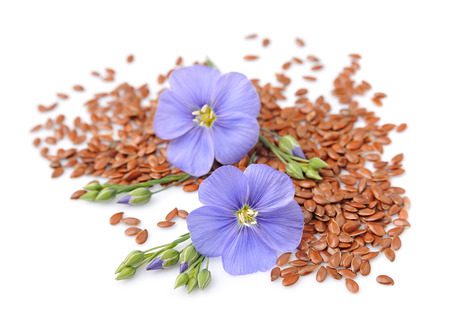Herb
Atasi (Linum usitatissimum) Herb Ayurvedic Overview
Atasi (Linum usitatissimum), commonly known as Flax Plant, consists of dried, ripe seeds of Linum usitatissimum Linn. (Fam. Linaceae). It is an erect annual herb, 0.6-1.2 m high, extensively cultivated throughout the plains of India like Uttar Pradesh, Bihar, and West Bengal up to an altitude of 800 m. Atasi is one of the best and proven remedies in Vata-related diseases.
It bears blue-violet five-petaled flowers. The flattened, shiny light brown seeds are borne in an eight- to a ten-seeded capsule from the flower. These seeds can be used as food as well as medicine. The tiny-shiny-smooth seeds are considered Superfood due to their ability to boost immunity and prevent various diseases.
Atasi is one of Omega 3 fatty acid’s best source and contains palmitic, stearic, oleic, linoleic acids, amino acids, mucilage (3-10%), fatty oil (30-40%), and glycosides. It is rich in anti-inflammatory, anti-oxidant, lipolytic, antiplatelet, anti-tussive, cardiotonic, digestive, diuretic, expectorant, estrogenic, anti-tumor, analgesic properties and works effectively in fever, malaria, constipation, diabetes, blood cholesterol, gout, backache, cold, cough, obesity, high blood pressure, severe headache, etc.
Atasi or Alsi might be considered a helpful additive in cosmetics as it is beneficial for the skin due to its antioxidant and antibacterial activities. Applying Alsi oil on the skin effectively manages skin allergies, skin inflammation and speeds up wound healing due to its antioxidant property.
Table of Contents
Scientific Classification of Atasi (Linum usitatissimum):
- Kingdom: Plantae
- Subkingdom: Tracheobionta
- Superdivision: Spermatophyta
- Division: Magnoliophyta
- Class: Magnoliopsida
- Subclass: Rosidae
- Order: Linales
- Family: Linaceae
- Genus: Linum L.
- Species: Linumusitatissimum L.
Atasi (Linum usitatissimum) Synonyms:
- Sanskrit: Uma, Ksuma
- Assamese: Tisi, Tusi
- Bengali: Masina, Atasi
- English: Linseed
- Gujrati: Alshi, Arasi
- Hindi: Alsi
- Kannada: Agasebeeja, Semeagare, Agasi
- Kashmiri: Alsi
- Malayalam: Agastha, Agasi, Cheru charm
- Marathi: Atshi
- Oriya: Atushi
- Punjabi: Ali
- Tamil: Ali, Virai
- Telugu: Avisa
- Urdu: Alsi, Katan
Atasi (Linum usitatissimum) Description:
 a) Macroscopic: Atasi (Linum usitatissimum) seeds are tiny, brown, glossy with a minutely pitted surface. It is about 4-6 mm long and 2-2.5 mm width, elongated-ovoid, flattened, rounded at one end, and obliquely pointed at the other. The fruit is round, having 5–9 mm diameter, containing several glossy brown seeds shaped like an apple pip, 4–7 mm long.
a) Macroscopic: Atasi (Linum usitatissimum) seeds are tiny, brown, glossy with a minutely pitted surface. It is about 4-6 mm long and 2-2.5 mm width, elongated-ovoid, flattened, rounded at one end, and obliquely pointed at the other. The fruit is round, having 5–9 mm diameter, containing several glossy brown seeds shaped like an apple pip, 4–7 mm long.
Near which on one edge, a light depression enclosing hilum and micropyle. The embryo is consisting of two yellowish-white, flattened plano-convex cotyledons and one radical. It nearly filled the seed and surrounded by a thin, whitish endosperm, testa mucilaginous when soaked in water, odor, characteristic, taste, oily when chewed.
b) Microscopic: The transverse section of the Atasi (Linum usitatissimum) seed shows testa consists of isodiametric cells with mucilaginous on outer walls. The collenchymatous cells of the middle layer of origin are single-layered, cylindrical, yellowish-brown, longitudinally elongated, about 120-190µ long, and 14-17 µ wide. The seed has lignified and with pitted walls, a single layer of flattened polygonal pigment cells with reddish-brown contents.
Identity, Purity, and Strength of Atasi (Linum usitatissimum):
- Foreign matter Not more than 1 percent, Appendix 2.2.2.
- Total Ash Not more than 5 percent, Appendix 2.2.3.
- Acid-insoluble ash Not more than 2 percent, Appendix 2.2.4.
- Alcohol-soluble extractive Not less than 30 percent, Appendix 2.2.6.
- Water-soluble extractive Not less than 15 percent, Appendix 2.2.7.
- Fixed oil Not less than 25 percent, Appendix 2.2.8
Chemical Constituents of Atasi (Linum usitatissimum):
The chemical constituents are Fixed oil, mucilage, protein, Campesterol, Sitosterol, Cycloartenol, etc.
Ayurvedic Properties and Action of Atasi (Linum usitatissimum):
- Rasa: Madhura, Tikta
- Guna: Guru, Snigdha
- Virya: Ushna
- Vipaka: Katu
- Karma: Vataghana, Akchushaya
Ayurvedic Formulation made by Atasi (Linum usitatissimum):
The most important formulations of Atasi (Linum usitatissimum) are: Sarshapadi Pralepa, Kolakulathadi churan, Gojihwadi Kshayam, Atasyadilepa.
Therapeutic Uses of Atasi (Linum usitatissimum):
The therapeutic uses of Alsi are Krimiroga, Kushthaghana, Prameha, Siroroga, Vataghani, Medohara.
Dose of Atasi (Linum usitatissimum):
3-6 gm of the drug in powder form.
Reference:
Ayurvedic Pharmacopeia of India.


